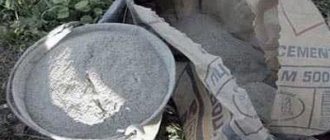Every man, without exception, has encountered repair work of varying levels of complexity at least once in his life. As for building materials, they are stocked up in advance, and in considerable quantities. There are often cases when a huge supply of a material such as cement is collected. In this case, it is necessary to take care of the safety of the expensive component over any period of time while maintaining its original qualities. In winter, construction work is carried out less frequently, and therefore the cost of materials is significantly reduced.
How to store cement in winter in a garage or other cold room
The place chosen for storing cement, regardless of how long it will be placed there, must meet a number of requirements:
- no draft;
- adequate ventilation;
- minimum temperature +5°C;
- low humidity.
Storage of cement in basements and cellars is allowed, but not recommended. This is due to the increased humidity that is present there.
Before laying containers indoors, you should check the roof for integrity. If melt water or snow gets inside the room, the cement will be damaged. Bags of cement are placed on pre-set pallets or wooden logs. It is recommended to wrap the bags with polyethylene and cover them with thick fabric after laying. Tarpaulin or thick polyethylene works best. The distance of the bags from the wall should be at least 35 cm.
Cement that is in spoiled or damaged containers cannot be stored for a long time, regardless of the location and conditions. Different brands of cement should be stored separately from each other. Otherwise, the quality of the material will deteriorate.
If a large number of bags of cement are to be stored, then laying is carried out alternately (across and lengthwise). Thus, the structure will be as stable as possible. It is allowed to construct a structure of 15 packages in height and no more than 3 m in length. There should be a regular supply of fresh air, but drafts should be completely avoided.
During the winter, the premises should be heated or the warehouse temperature maintained above zero. The quality indicator of stored materials may decrease even if all requirements are met. This will lead to an increase in material consumption by 1.5 times. Only in this way will the cement layer have optimal strength.
Arrangement of the premises
If you are going to store the bulk mixture for a longer time, you need to properly prepare the room. The bags should be placed on a special flooring. The room where the bags of cement will be located must be dry and well ventilated. If there is no ventilation, moisture will begin to accumulate in the room. To ensure the necessary ventilation, you can use the simplest forced ventilation.
The video explains how to preserve cement in winter:
You can see how walls are plastered with cement mortar in the video from the article.
When there is no ventilation in the room, two pipes can be taken outside. One should be installed 0.5 m above the floor, the other 0.5 m above the ceiling. Thanks to such measures, it will be possible to ensure excellent air movement, because it is better to spend time arranging ventilation than to later buy new cement.
In addition to arranging your premises, you must adhere to the following rules:
- You cannot store cement of different brands nearby, because they contain different amounts of moisture. Otherwise, you may degrade the quality of the cement.
- For those who plan to store the material for more than 6 months, it is necessary to wrap each bag in 2-3 layers of polyethylene. Thanks to such measures, you can additionally protect the product from moisture. Thus, it is possible to preserve the quality of cement even when stored for more than a year.
- If you store cement for a long time, then during the preparation of the solution you need to increase the consumption by 1.5 times. For example, if you take 2 kg of fresh product, then in the current situation you will need 3.5 kg.
Using a silo to store cement
Silos can also be used to store construction materials. It is an equipped bunker, for the manufacture of which metal is used. Externally, the silo resembles a large cylindrical building, which is equipped with an entrance for supplying stored raw materials. Inside the structure there are cleaning filters, holes for ventilation and for adjusting air humidity. Such structures are usually used on a production scale.
Cement storage silos
There are several types of silos. An example would be structures that are used when there is a small space allocated for production. Container or mobile silos are in great demand. With their help, you can transport building materials over long distances.
Advantages of the structures:
- convenience;
- high protection rate;
- ease of use;
- durability.
It is incredibly difficult to store cement at home, so it often becomes unusable after a relatively short period of time. However, even after its service life has expired, some gardeners use it to fertilize the soil. It can replace chalk or lime.
What determines the storage duration?
There are many reasons why the quality of cement can deteriorate even in a short period of time, not to mention its long-term storage. Everyone knows that you can’t keep bags in the open air, especially when it’s expected to rain. But moist air is just as dangerous to the mixture as water. Cement absorbs moisture very well through any packaging. The result of this will be the formation of lumps due to the process of hydration (binding of grains).
It is important to know that the higher the grade of cement, the less able it is to last for a long time. For example, high-quality Portland cement of grade 500, after sixty days of aging in a warehouse, will only meet the characteristics of M400. If the mixture also has a fine-grained fraction, then the degradation process is significantly accelerated. After storing cement of any brand for a year, it can only be used for non-critical structures.
Air saturated with carbon dioxide worsens the properties of the material. Therefore, it is not recommended to store cement for a long time in heavily gassed rooms (boiler rooms, stokers), if there is no proper ventilation there. The same applies to damp warehouse areas and unventilated hangars.
Shelf life of cement
The shelf life of cement will primarily depend on the humidity level in the room. The material can become damp quickly, thereby losing all its properties.
If the material in the bag has hardened, then its subsequent use is not possible.
The higher the grade of the stored material, the faster the cement will deteriorate. The 500th cement, if stored incorrectly, will turn into the 400th cement after a month. This indicator is extremely important when it comes to the quality of future concrete. More material will be needed if low grade cement is used. After a year of improper storage, the 500th cement can be used exclusively for laying tiles in the garden.
| Concrete grade | Cement M-400 | Cement M-500 | ||
| Mass composition (kg) C : P : SCH : V | Volumetric composition (kg) C : P : SH : V | Mass composition (kg) C : P : SCH : V | Volumetric composition (kg) C : P : SH : V | |
| M100 | 1 : 4,6 : 7,0 : 0,85 | 1 : 4,1 : 6,1 : 0,85 | 1 : 5,8 : 8,1 : 0,9 | 1 : 5,3 : 7,1 : 0,9 |
| M150 | 1 : 3,5 : 5,7 : 0,75 | 1 : 3,2 : 5,0 : 0,75 | 1 : 4,5 : 6,6 : 0,85 | 1 : 4,0 : 5,8 : 0,85 |
| M200 | 1 : 2,8 : 4,8 : 0,63 | 1 : 2,5 : 4,2 : 0,63 | 1 : 3,5 : 5,6 : 0,71 | 1 : 3,2 : 4,9 : 0,71 |
| M250 | 1 : 2,1 : 3,9 : 0,56 | 1 : 1,9 : 3,4 : 0,56 | 1 : 2,6 : 4,5 : 0,64 | 1 : 2,4 : 3,9 : 0,64 |
| M300 | 1 : 1,9 : 3,7 : 0,5 | 1 : 1,7 : 3,2 : 0,5 | 1 : 2,4 : 4,3 : 0,6 | 1 : 2,2 : 3,7 : 0,6 |
The packaged material has a shelf life of six months, but after this time period it will lose almost half of its original qualities. Large developers buy bulk material, which is not stored for a long time. True, no one will store it for that long, since after the material is delivered to the construction site, it is immediately used. Small production shops neglect such information.
Before purchasing the composition, it would be a good idea to look at the certificate. The distance from the pallets to the ground should be at least 35 cm. The room used needs regular and thorough ventilation. To preserve the product throughout the winter, three basic conditions must be met:
- The tightness of the container used.
- Positive room temperature.
- Low humidity level.
Options for using expired or damaged cement: all the pros and cons
There is an opinion that crushed fossilized cement can be used along with fresh cement in a 1:1 ratio. They also say that it is not bad as sand in construction mixtures and is great for blind areas. All of the above is complete nonsense. However, such building material can indeed be used, but only in a slightly different way.
A crack in the foundation is no longer a problem, but a disaster
Mixing old cement with fresh cement
This is indeed possible, but the proportions are slightly different. For one part of old cement ground into sand, add 10 (!) parts of fresh cement. And at the same time, such building material can no longer be used for the construction of residential buildings. It can only be used to raise the foundation of a small bathhouse, shed or garage.
Trowel and a pile of cement mortar
Get rid of potholes from the road near the house
This material can be used to fill up potholes on the road near the house, which are not uncommon in private sectors. The rains will do their job, the compacted cement will harden, and the ride will become much more comfortable.
Crushed old cement will fix the problem on the road. Until the next rain
Using lumps and crushed cement for backfilling pillars
This is where experts agree that expired, caked cement is perfect for backfilling posts when building fences. Of course, the old cement has lost its properties, but not completely. When backfilling it is compacted, and then, under the influence of melt water and precipitation, it is further strengthened. Therefore, the pillars stand quite firmly.
What to do with leftover cement?
Landscaping works
There is complete freedom here for the home craftsman. Old cement will perform well if it is mixed with fresh cement and used to cast various figures or benches. However, it is best to use it as a cushion under paving slabs of paths. Crushed old cement will help level the area for the finishing coat. In this case, you will not need to waste fresh building material; you can only get by with compacted cement.
Use of leftover cement
Source
How to preserve cement in different conditions
Craftsmen who have purchased cement in reserve are thinking about how to properly store it until needed. In an unheated dacha, the material will be stored much better compared to rooms where frequent temperature changes occur. Creating good ventilation is paramount. Thus, you can control the humidity level in the room and eliminate drafts. Direct sunlight can damage the product and should also be avoided.
The same situation applies to storing material in the garage. An unheated garage space is much better. However, the integrity of the packaging will be of paramount importance. Regularly changing containers will only worsen the quality of the product. A room in which the temperature is at +5°C is best suited for storing cement. It is not recommended to keep the material outside.
Conditions for storing cement in bags in winter
When storing material throughout the winter, the rules for its preservation are somewhat different from the usual ones. Exposing the material to frost should be completely avoided. The room may be heated. Low temperatures negatively affect the quality of the material, bringing it closer to its unsuitability. The optimal temperature regime used for storing cement in bags in winter is +5°C - +8°C. The higher the temperature, the lower the humidity indicator will be, which is extremely important.
Different brands of cement should not be stored nearby, since the percentage of moisture content in each brand is different. When placed close together, different grades of cement will lose some of their qualities.
How long do different brands last?
The difficulty in storing cement lies in the fact that this material has increased moisture-absorbing properties. It actively absorbs moisture from the environment and reacts with carbon dioxide, which negatively affects the strength characteristics of the final solution.
Each batch of cement is tested for strength under production conditions, which allows the material to be marked in increments of 100. The lowest grade of building material is designated M100 - it provides the least durable composition. M600 has the highest strength characteristics. High grade cements are more demanding on storage conditions and have a shorter shelf life.
The deadlines are regulated by GOST 30515-97 “Cements. General terms and Conditions". According to this standard, the following storage periods for the material are established:
- M600 - 3 months;
- M500 - 6 months;
- M400 - 6 months;
- M300 - 12 months;
- M200 - 12 months;
- M100 - 12 months.
Cement is stored much less in unpacked containers:
- M100—M300 — 60 days;
- M400—M600 — 45 days.
After this period, the building material must not be used.
There is a pattern - every three months cement loses about 15% of its initial strength characteristics. Therefore, you need to use the material as soon as possible after purchase.
How to store cement in a cold room in winter
Any room in which you can regulate the temperature and humidity conditions is suitable for these purposes. The room should not be frozen or damp. Over time, if the room is not ventilated, the humidity will increase greatly. Regular ventilation is mandatory. Storage in a cellar, underground or basement is not recommended. Utility rooms without heating are suitable only if the temperature in them meets the indicators declared by the manufacturer. Cement is not stored in bags in cold rooms.
Main methods of storing material:
- use of containers or sealed barrels;
- pallets.
Preparatory work includes the following manipulations:
- Wooden pallets used as a base must be kept away from the ground. The indicator will be 35-50 cm. If necessary, bricks are used to adjust the height.
- Pallets are not installed close to the wall. The distance between them will be 30 cm or more.
- Opened or whole bags should be wrapped in film. Open bags are sealed with tape and secured with a stapler.
- Laying is carried out in a stack. The ranks change. The first one goes along, the second one will go across.
- The material is covered with a tarpaulin on top. One side remains open.
- The bags are turned over once every two months.
Storage features and temperature conditions
To ensure the safety of cement in winter, it is necessary to take into account humidity parameters and air temperature. Exposure to snow and frost will lead to the death of the building material. Within a day it will turn into a useless mass.
The recommended humidity level for cement preservation is 50-60%. The temperature should be no less than + 5 C.
In such conditions, unopened bags can be stored according to the GOST expiration dates; if the container has been opened, the shelf life is reduced. Every month, cement from an opened package loses about 15% of its properties. Cement loses the same amount from a whole package, but in three months.
If it is impossible to provide the necessary storage conditions, you should avoid purchasing material in large quantities.
Storing cement indoors
A suitable room is considered to be one in which temperature and humidity conditions can be ensured. The room must be absolutely dry and not freezing. A prerequisite is the possibility of ventilation, without which the humidity of the room increases.
Cement should not be stored in winter conditions in a cellar, basement or underground. A garage or any other utility room without heating is also not recommended. Cement should not be stored in a cold room in winter.
Methods for storing cement indoors:
- On pallets. Euro pallets or self-made flooring from boards are suitable.
- In a barrel or container.
Cement should be stored on pallets in winter
How to store cement outside in winter
Almost no one succeeds in preserving material outdoors during the cold months. This is due, first of all, to the lack of stability of climatic conditions. For short-term storage, the street can be used, but the temperature outside the window should be +5°C or more.
To protect the material from wet snow you will need:
- store bags under a canopy;
- place the material exclusively on pallets;
- Cover the top with thick, water-repellent material.
If there is no canopy, a tarpaulin is used. If the weather is stable, cement can be stored for two days in such conditions.
Factors indicating that the powder should not be used
In this case, it is sufficient to correctly conduct a tactile analysis of the powder without the use of any instruments or laboratory methods. Having purchased bulk products, check its contents by taking a certain amount with your hand. The high quality binding powder flows through your fingers like liquid without clumping. Also, when purchasing packaged cement of any brand, feel the corners of the bag or big bag. They are not allowed to contain hardened pebbles.
If you have a suitable premises, and when checking the building materials, everything that is recommended by experts was hit, feel free to purchase a binder and begin repairs.
If you cannot quickly begin the planned procedures, it is best to postpone the purchase. Remember that even under ideal conditions, the tensile strength decreases and other properties of the building material deteriorate. It is for this reason that the binder component is used to prepare mounting mixtures almost immediately after purchase.
How to store cement at home
When storing cement in bags, the period of preservation of its original properties can be significantly increased. The main task is to prevent moisture from entering the material.
In addition, the following recommendations can be given:
- The material can also be stored outdoors. However, in this case, in addition to the fact that each bag is wrapped in polyethylene, it is necessary to lay thick fabric and polyethylene on each layer.
- To avoid the penetration of moisture from the ground, the bags are placed on pallets. The height of one of them is 50 cm or more. An insulating layer (polyethylene) is installed between the wood and the bags, since the material absorbs moisture well. It is also possible to use roofing felt and galvanized metal.
- To better preserve the original characteristics, the bags should be turned over every few months.
- Each bag is wrapped in polyethylene, which avoids the penetration of dampness and moisture into the container.
You can also watch this useful video:
Real expiration dates
There are two concepts about the shelf life of cement in bags: guaranteed according to GOSTs and real or actual. The second option differs from the first in that it can be artificially extended to six months or more. To achieve a similar effect, you can take (it turns out) simple actions:
- place unsealed bags for storage in a dry room;
- place the packages, regardless of volume, on a flat platform made of durable wood, maintaining a distance from the floor of more than 300 mm (these can be pallets, racks with boards);
- wrap low stacks (to prevent cement from caking) with technical polyethylene film in several layers and additionally in a container if we are talking about big bags.
And now about my neighbor's assumption about more expensive brands. Indeed, after the end of the period specified by the manufacturer, the material may still be suitable for construction. Of course, subject to storage rules. But the brand strength will decrease over time in comparison with the declared one by 15-35 units.
That is, after the expiration date of, for example, M500 cement, within about 1-2 months it will correspond to the technical characteristics of M400. That is, the neighbor is right - you can immediately purchase the material in full and use it with a small reserve, even against the backdrop of real dates.
How to preserve cement at your dacha in winter
Based on current state standards, the best containers for storing cement are paper bags. Their capacity can be 25, 40 and 50 kg. The paper will absorb unnecessary moisture, preventing the material from becoming damp and becoming less durable. To achieve optimal protection, manufacturers often alternate polyethylene with paper, which helps achieve a lamination effect. Paper, in turn, can be impregnated and bitumenized. In this way, the shelf life of cement can be extended even if the packaging is opened.
The shelf life of the material is short, so after opening it should not be stored in this form for a long time. If, after completion of repair work or in case of a forced break, there are open packages of cement left, then any sealed container, such as wooden barrels, should be used. The clips will help seal the package tightly by squeezing out excess air from the bag. After placing cement in a barrel, it is covered with sand. The barrel is closed with a lid and then wrapped in polyethylene. In this way, the shelf life of cement can be extended by a month.
Cements: general characteristics and markings
Cement is marked in accordance with strength tests with the letter M. The lower grade of building material is designated M100. The composition is intended for the preparation of concrete for structures that do not require strength. This is a curb stone or road repair. The cement marking step is 100. M600 grade building materials used in military buildings, dams, hydraulic structures, bunkers, and bridge supports have the utmost strength.
Stamps
There are several grades of cement with different purposes: M 500, M 400, M 300, M200. The higher the number, the greater the activity of the material, the stronger the building mixture.
The established period of time for storage depends not on its brand, but on the packaging container and storage technology.
The guaranteed shelf life for packaged material is 60 days, and in bulk - 45. The actual shelf life is 30 days for all brands of packaged cement, 20 - without it.
Tara
Cement is packaged in two ways: in bags weighing 50 kg and in big bags from 400 to 2000 kg. The bags consist of five- or six-layer paper and have a closed neck with a valve. The use of imported bags is allowed. In retail trade, for small packaging, plastic bags and cans are used.
Weight
The packaging is designed for a load of 50 kg, the permissible gross weight is 51 kg.
Soft modern industrial containers made from vacuum packaging are big bags. They hold from 0.4 to 2 tons of bulk material. The container has a sealing liner made of polyethylene; there are sewn-in slings for lifting operations. The container is completely insulated from moisture.
Polyethylene bags are small packaging, their weight is up to 25 kg. Cans and bags of lighter weight are used in retail trade.
The net weight of the package and the permissible error must be:
- 50 kg - 1 kg on both sides of the net;
- 0. –2 tons – +2. –1% of net;
- 10, 20 kg - 0.3 kg on both sides of the net;
- 3–5 kg - 0.05 kg from net.
If the permissible weight limits of GOST 30515-97 are violated, there is doubt about purchasing the material of the declared quality.
Each container is designed for certain conditions and volumes of work and the possibility of transportation.
What are the packaging requirements?
Must be sealed. Even a small gust will expose it to air, causing the material to harden and become unusable. Cement is packed in kraft paper bags. Disposable plastic bags and big-bag polypropylene containers have become popular.
Cement storage rules
Leaving cement in the open air is not recommended. Even during the process of mixing cement mortar, all manipulations should be carried out under a canopy. The room chosen for storage should be well ventilated, warm and dry. In a closed room, moisture and carbon dioxide quickly accumulate, which negatively affect the material. Negative temperatures can also speed up the process of cement deterioration. Experts do not recommend using basements, since this is where the greatest amount of moisture accumulates.
Warehouses and attics must be heated or warm. The manufacturer claims that the material can be stored throughout the winter provided that the temperature is +5°C and above. In the absence of natural ventilation, ventilation is carried out independently. There are also several rules for placing bags. Bags are not laid on film or bare ground. Care should be taken to have a ventilated tray. A durable tarpaulin or several layers of polyethylene are placed on top of the bags. It should not be completely sealed.
For ventilation, leave one side open, which is towards the flow of fresh air. When using bulk cement, it is possible to use several storage methods: placing the mixture in a sealed barrel or subsequent packaging in special bags. The storage containers used have a volume of over 200 liters. Equipped with special latches. Plastic or wood is used to make containers.
5/5 — (1 vote)











